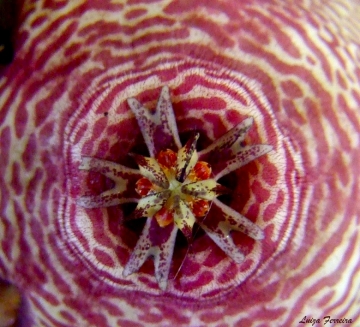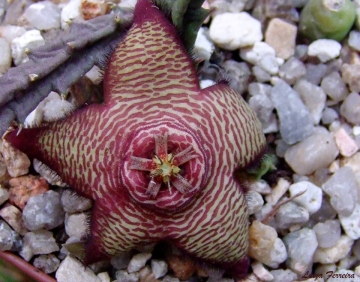
Stapelia mutabilis Photo by: Luiza Ferreira
Origin and Habitat: Stapelia mutabilisSN|30601]]SN|30601]] (Orbea mutabilisSN|30603]]SN|30603]]) is a plants raised from seeds in the Imperial garden at Vienna in 18th century from South African parents. It has never been found wild in South Africa. It is almost certainly and hybrid.
Synonyms:
See all synonyms of Stapelia mutabilis
back
Accepted name in llifle Database:Stapelia mutabilis Jacq.Stapel. Hort. Vindob. Cult. t. 29 1806Synonymy: 8
back
Common Names include:
RUSSIAN (Русский): Стапелия изменчивая
Description: Stapelia mutabilisSN|30601]]SN|30601]] (Orbea mutabilisSN|30603]]SN|30603]]) is a controversial name describing almost certainly a hybrid raised from seeds of Tromotriche revolutaSN|28289]]SN|28289]] (Stapelia revolutaSN|28290]]SN|28290]]), Masson, cross-fertilised by insect agency. There are several forms of it in cultivation, differing slightly in colouration and varying very much in the lobes of the outer corona, which in some forms rest upon the annulus and in others do not nearly touch it and are very variably toothed at the apex. The flowers remain expanded from 4–7 days. The varieties are doubtless only hybrid forms of it (often hybrid with Orbea variegataSN|19768]]SN|19768]]). A numbers of different clones (all named “Stapelia mutabilisSN|30601]]SN|30601]] or Orbea mutabilisSN|30603]]SN|30603]]” ) of uncertain provenance are from time to time available in the trade.
Following the description of N. E. Brown (1909):
Stems: 7-45 cm high, 12-18 mm across, square, acutely 4-angled, with slightly concave or flattish sides and rather stout conical spreading teeth about 6 mm long, glabrous, green, sometimes tinged with purple, slightly glaucous.
Flowers: 1–3 together, from near the base of the younger or higher up on the older stems, successively developed; pedicels 6-15 mm long, glabrous; sepals 5-9 mm long, ovate-lanceolate, acuminate, glabrous; corolla with the lobes very much recurved and then about 36 mm in diameter, glabrous on both surfaces, ciliate nearly or quite to the tips of the lobes with vibratile clavate purple hairs about 1.5 mm long, with the disk raised into an erect solid pentagonal annulus 3-4 mm high around and forming a short tube containing the corona, but flat on the back beneath it; lobes 14-22 mm long, 14-20 mm broad, broadly ovate, acute or shortly acuminate; back smooth, pale green tinged with purplish on the nerves and tips of the lobes; inner face slightly rugose to nearly smooth, with the apical third of the lobes light or dark purple-brown and the remainder pale yellowish or greenish-yellow, covered with transversely elongated spots or thick or narrow (and then crowded) irregular transverse purple-brown lines, becoming fainter on the annulus; outer corona-lobes 2.5-3 mm long,1.5-2 mm broad, rectangular or subquadrate, very variable in toothing, bifid, with parallel teeth, or with a small tooth in the notch and the outer edges of the lateral teeth tapering to the apex, or equally 3-toothed, or with 3 minute teeth projecting from the middle of the truncately contracted apex, pale yellowish, speckled with purple-brown and often with a broad central stripe of the same colour; inner corona-lobes 2-horned, pale yellowish, thickly dotted with purple-brown; outer horns suberect or ascending, 2-3 mm long, filiform, slightly clavate at the apex; inner horns 4 mm long, filiform, connivent-erect, recurving at the clavate tips; odour not very strong but disagreeable, sometimes odourless; follicles subparallel, 18-20 cm long, about 10 mm thick, terete-fusiform, tapering into a long hooked beak, smooth, glabrous.
Bibliography: Major references and further lectures:
1) N. E. Brown. “Flora Capensis”, Vol 4, 1909
 Stapelia mutabilis Photo by: Luiza Ferreira
Stapelia mutabilis Photo by: Luiza Ferreira Stapelia mutabilis Photo by: Luiza Ferreira
Stapelia mutabilis Photo by: Luiza FerreiraCultivation and Propagation: Stapelia mutabilisSN|30601]]SN|30601]] is an easy obliging blooming plant when mature, that it is happy in any average succulent house.
Potting:Since roots are quite shallow, use a soft and incoherent cactus mix or add extra perlite or pumice to regular soil potting soil, and clay pots help the plants to dry out between watering.
Waterings: It require moderately watering through the growing season but enjoy plenty of water and some fertiliser in hot weather, this helps them to flower freely. Water more sparingly in winter according to temperatures. But, as with most asclepiads, it is unwise to leave them wet in cold weather.
Fertilization: Fertilizers for succulent plants must be rich in potassium, but poor in nitrogen, to avoid the plants from developing excess vegetation, which is easily attacked by fungal diseases.
Sun Exposure: As with many succulents, they prefer to grow in the light shade of scrubby shrubs or between rocks where they get some shade during the day. In summer it is advisable to position this plant in a partially shady place, where it is exposed to direct sunlight only during the coolest hours of the day.
Hardiness: These plants don't like cold weather, therefore in the Spring it is best to set them outside only when the temperatures are above 15°C. Can endure temperatures below 5°C for short period, but only if the soil stays completely dry.
Pest and diseases: Stapelia species vary in their susceptibility to rotting, but are generally fairly easy to grow, especially if kept pest-free. They are very susceptible to stem and root mealy bugs, and damage from these may well initiate fungal attack. If you do have problems with a stem or with basal rotting, you can reliably isolate the healthy parts, dry them off, and re-root them in moist compost.
Cultural Practices: Re-pot every 2 years.
Propagation: Easiest with stem cuttings. Allow cuttings to dry a day before planting. Stems must be laid (Not buried) on gritty compost and will then root from the underside of the stems. It can also be increased from seeds sowing in spring in moist, sandy peat moss. Barely cover seeds. Seeds germinate quickly.












